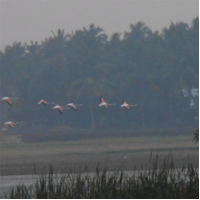Written by Ganeshwar SV
Having completed my Vedanthangal Bird Sanctuary trip with Puducherry Science Forum, only two weeks were left for an international event and it was the time when I was studying bird field guides like a higher secondary student preparing for his board examinations. I was so excited in the prospect of participating in the Great Backyard Bird Count for the first time in 2014. This global annual event gives us a yearly snapshot of the distribution and abundance of birds present in any location. Through Citizen Science initiatives like the GBBC, we can contribute as much as we can in conservation issues that are being done for the natural world with reference to birds in particular here.
On the first day of the Count, February 14, along with Aishwarya, a chartered accountant, we reached my favorite birding hotspot, the Kannankurichi Lake which is a 15-minute drive from home. “Keech…keechc keech…” was heard as we got down in the lake bund. As the calls of the common birds were quite familiar to me, without turning to the direction, I wrote YBBA in my field note (short for Yellow-billed Babbler). Three Black-crowned Night-Herons left the lake, probably to their roost site.
FIRST RECORD for SALEM
Exactly at 06.25 am, she pointed at some huge birds flying at a distance. It should be Painted Storks or Openbills, I mumbled to myself and lifted my binoculars. As they were flying in the opposite direction to which we were standing, all I could see was their silhouette and the grey clouds bracing the Shevaroy hills in the back drop. As they made a sharp left turn, Holy gosh! I was stunned! I’ve seen them in pictures and in documentaries of the natural history legend Sir David Attenborough. It was my long time dream to see them at Pulicat or Point Calimere where these birds would gather in astonishing numbers painting the regions with their lovely pink. It is certainly of no surprise if I had seen them in those two locations. Now, I was standing at Kannankurichi Lake in Salem city surrounded completely by human habitations and disturbances. Long necks with unique beaks, thin scaly legs, a reminiscent of their evolution from reptiles and their burning pink in the golden light of that auspicious morning revealed their identification as Greater Flamingos. I started jumping in joy. My eyes got fixed on those seven magnificent beauties and even for a split second I hardly took my eyes from them in the one hour duration which they stayed in the lake. This was the first time ever that Flamingos have been recorded in Salem with photographic evidence and I was so proud of my tiny camera.

I called my mom immediately to drop all the household chores and be at the lake next moment. As is the case with all moms, she came quite late bringing some breakfast for her son. Fortunately flamingos stayed until her arrival.
FILTER BEAKS and V-FLIGHT
Among the six species of Flamingos found worldwide, Greater Flamingos are the biggest and most abundant. These pinkies breed in parts of Gujarat, India and winter in coramandel coast of southern India in huge flocks numbering tens of thousands. Similar to the tea filter used at home, the unique beak of the bird performs a similar function by filtering planktons, blue green algae, and molluscs to feed. Beta-carotene, a pigment in the food which they consume is the reason for their feathers being pink. This level of carotene content differs in food in different places of the earth. This is the reason why Flamingos in the United States are deep orange in color and Flamingos found in India are pink. If their food intake is less with carotene supplements, it will lead to the loss of pink in their feathers.
After mom’s departure I stayed till afternoon, counting Marsh Sandpipers, Rosy Starlings, Blue-tailed Bee-eaters, Whiskered Terns, and Grey Wagtails, all in appreciable numbers. With the Sun at its peak, I no longer had the energy to celebrate for every new species which was getting added.
I observed that their flight was defined with great precision. A V-formation is the most efficient means of flying to conserve energy. In order to reduce the effect of gravity during flight, birds like ducks, storks fly in V-formation to travel long distances rather than to fly singly and waste more precious energy.

INDICATORS OF CHANGE IN CLIMATE
Threats to migratory birds have risen due to habitat loss and poaching being one of the prime causes and especially birds like flamingos which are surface feeders are affected by toxic chemicals in case if the water body which they visit is contaminated. It is hard for anyone to deny that most of the water bodies today are under severe pressure of pollution. Recording the migratory birds every year will help us in better understanding of the changes happening to our climate and environment. Migratory birds from India and other countries come here with complete trust in us that we will provide a good environment as their only goal is to keep themselves alive until they return to their breeding grounds. It is well known that Tamil Nadu is a classic example of hospitality, so wherever we are, it is our duty to love and respect humans, birds and all life.
NOTE: The Tamil version of this article was published in THE HINDU Uyir Moochu.

